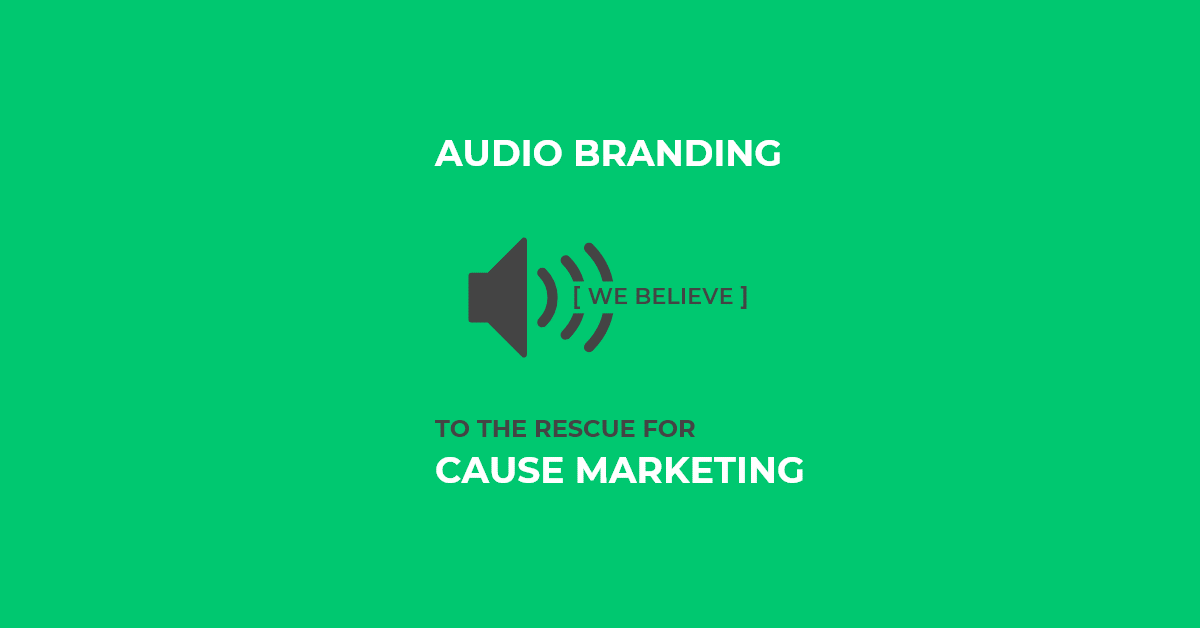Audio Branding to the Rescue for Cause Marketing
This article was originally published in Brandingmag on October 3rd, 2019.
A recent study from DoSomething Strategic states that brands are missing the mark on how to get cause marketing right for young people. Only 12% of the survey respondents had top-of-mind associations between brands they were familiar with and a social cause.
One of the main conclusions of the research was that in order to show they are trustworthy, on-point, and committed to a cause, brands must extend their good work beyond single campaigns. In the eyes of the youth, marketing for a cause stands for a holistic commitment and a proven track record of going out on a limb to make a difference. Having a purpose must be deep-seated and exhibited thoroughly in brands’ activities.
Participants were also asked how they typically hear about a brand’s association with a cause. The results paint the kind of picture you would expect to match the worldview of these digital natives. Among the top five sources were advertising, online communities, social media, “just a guess,” and influencers on blogs, YouTube, and elsewhere on the Internet.
So how can brands transcend something as intangible as ‘purpose’ to meaningful and sustainable brand appeal in such a fast-paced, disparate, and inorganic environment as the digital domain?
The answer is audio branding.
From the early days of bebop and rock n’ roll to the punk days, the MTV era, and hip hop epoch, the hallmark traits of youth movements have come to life in the melodies, lyrics, and beats of the times. Even though the modern, globalized world is more fragmented than ever in tastes, views, and attitudes, studies on Gen Z-ers’ relationship with music show there is still some emotional traction left.
People in this age group cite music as very important to their lives. 92% of the respondents in a Sweety High study said the music they listen to impacts their mood significantly. What’s more impressive from a business point of view, 74% of young adults believe they develop a better understanding of a company’s personality through music.
Gen Z-ers are accustomed since birth to the modern way of living, where digital devices and the Internet are becoming accessories for monitoring, distinguishing, and labeling human emotions, and even influencing people’s thinking and behavior. In fact, today’s youth understand, perceive, and navigate the online buying space in a way that is pushing brands to produce more authentic content. This is where the impact of audio branding comes into play.
A campaign from the Canadian snack brand Pizza Pops from a few years back shows how strategic sound can drive ‘brand meets cause’ efforts in the digital domain. The aim of the campaign was to highlight the teenage pressures of looking good while showing that being weird is okay and can be cool.
Each video features a synchronized display of the company logo and a “Pizza Pops!” shout. This alone is enough to create the kind of multisensory memory mark that sticks like a spot on a teen’s face. Acoustic instrumentation makes the music sound humane, while the melancholic piano combined with the overall context of the ad creates a perfect impression of parody. The video comes to its weird, but funny closing with the song cutting abruptly as a Pizza Pop flops onto a plate.
In fact, the absence of music, especially in shorter ads, shows that silence can work as a strategy too. In their case, it’s an especially powerful one, as it makes the young characters’ tension and awkwardness so palpable in this digital format.
Imagine if the audience were to hear similar kinds of branded sound snippets at pop-up stands, charity events, stores, and installments as in these digital campaigns. Through social media, apps, podcasts, radio, and very soon in voice assistants and smart speakers, sound will serve as the emotional anchor for a brand’s presence and elucidates its affiliation with the cause.
Our hearing is a central element of pretty much all of the consumer touchpoints out there, screens on or off, real-world or not. If you are a cause marketer, it’s time to stop overlooking sound’s capacity for impact and long-term brand building. It’s time to make it a fundamental creative, strategic building block, rather than leaving it as an afterthought in production.
When music becomes a part of a larger holistic design, any attitude, idea, or solution can transcend to humane means of interaction and appeal. This kind of brand equity will be priceless in competing for the attention of these tech-savvy future stakeholders, business leaders, and consumers.






